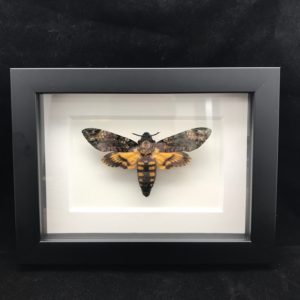Description
Four Beautiful Small Crabs in a Black Wood Frame. These are beautifully detailed and meticulously posed.
You will receive this exact frame. The frame is 6″ x 13″ x2″.
Crustaceans are a diverse group of arthropods that include species such as crabs, lobsters, shrimp, crayfish, and barnacles. They are primarily characterized by their hard exoskeletons, jointed limbs, and segmented bodies. Crustaceans are found in a wide range of habitats, mostly in aquatic environments, both marine and freshwater, though some species can also live on land.
Key Characteristics of Crustaceans:
- Exoskeleton: Crustaceans have a tough outer shell called an exoskeleton made of chitin, which provides protection and support. As they grow, they must molt, or shed their old exoskeleton, to allow for new growth.
- Segmented Body: The body of a crustacean is typically divided into three main sections: the head, thorax, and abdomen. These segments are often fused or modified depending on the species.
- Jointed Appendages: Crustaceans have jointed legs and other appendages, such as antennae, which help them move, feed, and sense their environment.
- Eyes: Most crustaceans have compound eyes, which provide a wide field of vision.
- Respiration: Crustaceans typically breathe through gills, although some terrestrial species (like certain crabs) have adapted to breathe air.
Classification of Crustaceans:
Crustaceans are a subclass of arthropods and are divided into several orders:
- Decapods: This includes crabs, lobsters, and shrimp. These species generally have ten limbs (hence the name “decapod”), with five pairs of legs.
- Isopods: This group includes pill bugs and sowbugs, which are mostly terrestrial but some are aquatic.
- Amphipods: Small crustaceans that are often found in marine or freshwater environments, like the common “sand flea.”
- Copepods: These are tiny, planktonic crustaceans that are important in aquatic food webs.
- Barnacles: Though they may appear different, barnacles are crustaceans. They live attached to surfaces such as rocks, ship hulls, and marine animals.
Ecological Role:
Crustaceans play crucial roles in ecosystems:
- Food source: They are an essential part of many food webs, serving as food for a wide range of predators, from small fish to large marine mammals.
- Scavengers: Many crustaceans are scavengers, feeding on dead plant and animal material, helping to recycle nutrients.
- Biodiversity indicators: They can serve as indicators of environmental health, as they are sensitive to pollution and habitat changes.
Human Interaction:
- Fishing and Aquaculture: Crustaceans such as shrimp, lobster, and crab are commercially important for the fishing and aquaculture industries.
- Culinary Use: Crustaceans are widely consumed around the world, known for their delicate and often sweet flesh.























